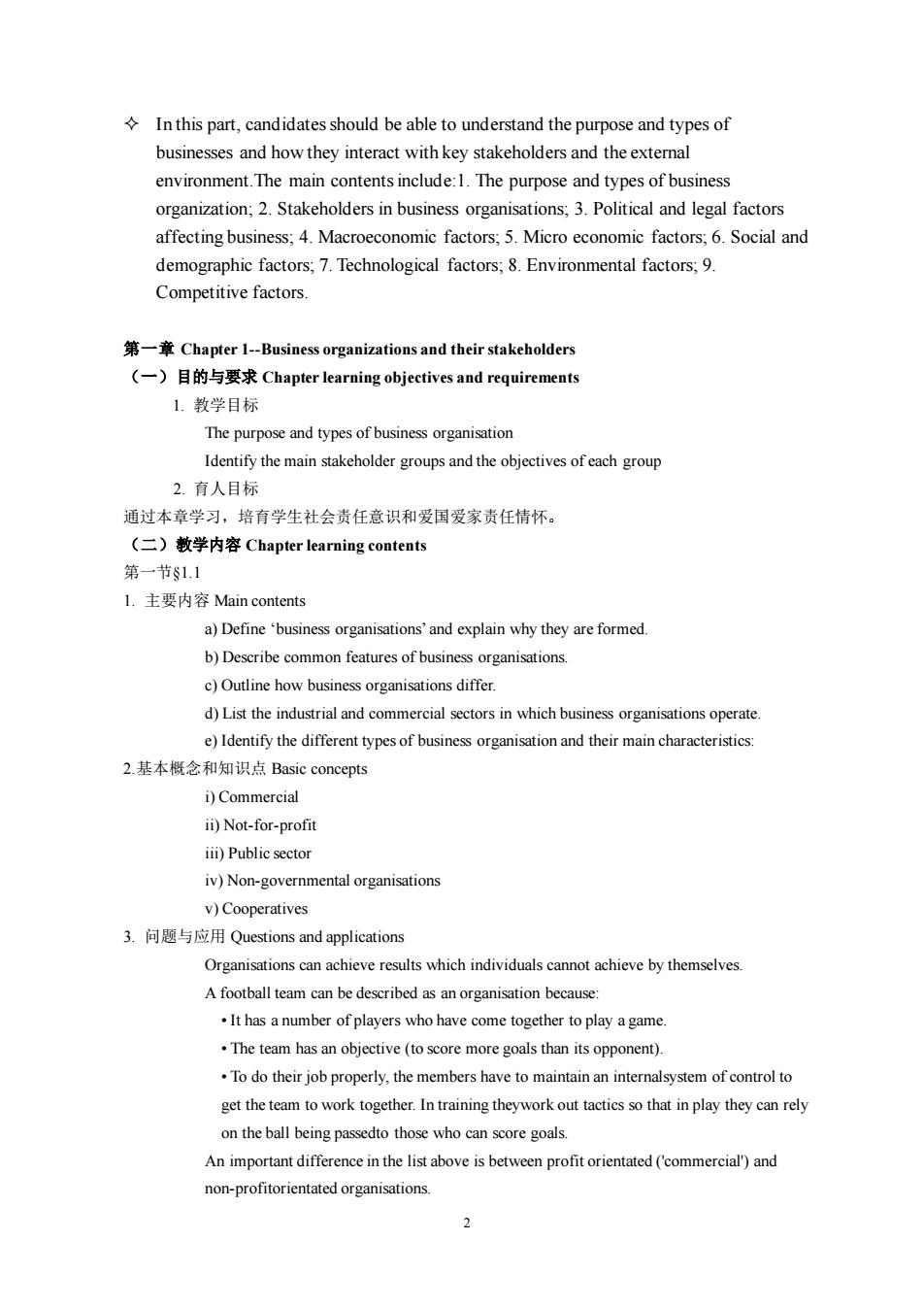正在加载图片...

In this part,candidates should be able to understand the purpose and types of businesses and how they interact withkey stakeholders and the extemal environment The main contents include:1.The purpose and types of business organization;2.Stakeholders in business organisations,3.Political and legal factors affecting business,4.Macroeconomic factors,5.Micro economic factors,6.Social and demographic factors;7.Technological factors,8.Environmental factors,9. Competitive factors 第一章Chapter 1-Business organizations and their stakeholder (一)目的与要求Chapter learning objectives and requirements 1.教学目标 The purpose and types of business organisation Identify the main stakehoder groupsand the objectives 2.有人目标 通过本章学习,培有学生社会责任意识和爱国爱家责任情怀 (二)教学内容Chapter learning contents 第一节1.1 L.主要内容Main contents a)Definebusiness organisations'and explain why they are formed b)Describe common features of business organisations. )Outline how business organisations differ d)List the industrial and commercial sectors in which business organisations operate e)Identify the different typesof business organisation and their maincharacteristics 2.基本概念和知识点Basic concepts i)Commercial ii)Not-for-profit iii)Public sector iv)Non-governmental organisations v)Cooperatives 3.问题与应用Questions and applications Organisations can achieve results which individuals cannot achieve by themselves. A football team can be described as an organisation becaus It has a number of players who have come together to play a game .The team has an objective(to score more goals than its opponent) .To do their job properly,the members have to maintain an internalsystem of control to get the te to work together.theyworkou tactics so that in play they can rely on the ball being passedto those who can score goals An important difference in the list above is between profit orientated(commercialand non-profitorientated organisations. 2 2 In this part, candidates should be able to understand the purpose and types of businesses and how they interact with key stakeholders and the external environment.The main contents include:1. The purpose and types of business organization; 2. Stakeholders in business organisations; 3. Political and legal factors affecting business; 4. Macroeconomic factors; 5. Micro economic factors; 6. Social and demographic factors; 7. Technological factors; 8. Environmental factors; 9. Competitive factors. 第一章 Chapter 1--Business organizations and their stakeholders (一)目的与要求 Chapter learning objectives and requirements 1. 教学目标 The purpose and types of business organisation Identify the main stakeholder groups and the objectives of each group 2. 育人目标 通过本章学习,培育学生社会责任意识和爱国爱家责任情怀。 (二)教学内容 Chapter learning contents 第一节§1.1 1. 主要内容 Main contents a) Define ‘business organisations’ and explain why they are formed. b) Describe common features of business organisations. c) Outline how business organisations differ. d) List the industrial and commercial sectors in which business organisations operate. e) Identify the different types of business organisation and their main characteristics: 2.基本概念和知识点 Basic concepts i) Commercial ii) Not-for-profit iii) Public sector iv) Non-governmental organisations v) Cooperatives 3. 问题与应用 Questions and applications Organisations can achieve results which individuals cannot achieve by themselves. A football team can be described as an organisation because: • It has a number of players who have come together to play a game. • The team has an objective (to score more goals than its opponent). • To do their job properly, the members have to maintain an internalsystem of control to get the team to work together. In training theywork out tactics so that in play they can rely on the ball being passedto those who can score goals. An important difference in the list above is between profit orientated ('commercial') and non-profitorientated organisations